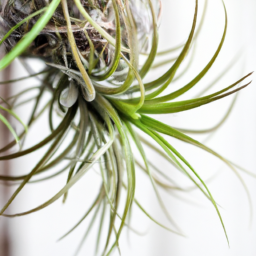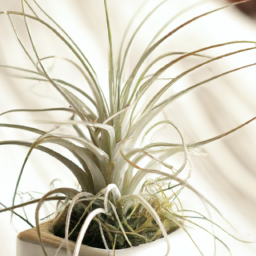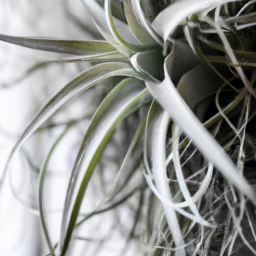
Air Plants: Minimal Care, Maximum Impact
Welcome to our blog post all about air plants! If you’re looking for a low-maintenance plant that can add a touch of greenery to any space, you’re in the right place. Air plants, also known as Tillandsia, are unique and fascinating plants that require minimal care while providing maximum impact. Whether you’re a seasoned plant enthusiast or just starting your green thumb journey, these little wonders are sure to capture your attention. In this post, we’ll explore the beauty and versatility of air plants, discuss their care requirements, and discover creative ways to display them in your home or office. So, let’s dive in and learn all about air plants and how they can transform your living spaces with minimal effort.
The Benefits of Air Plants in Minimal Care Gardening
Welcome to the world of air plants! These unique and fascinating plants, also known as Tillandsia, are gaining popularity in the world of gardening due to their minimal care requirements and maximum impact. In this article, we will explore the numerous benefits of incorporating air plants into your minimal care garden.
1. Enhance Indoor Air Quality
Air plants are not only aesthetically pleasing but also serve as natural air purifiers. They have the ability to remove toxins and improve indoor air quality, making them an excellent choice for indoor gardening. Unlike other houseplants, air plants don’t require soil to grow, which means they don’t trap dust or allergens. Their unique ability to absorb moisture and nutrients through their leaves allows them to filter the air efficiently. By adding air plants to your indoor space, you can create a healthier and fresher environment.
Moreover, air plants release oxygen during the night, making them ideal bedroom companions. This natural process can enhance your sleep quality and overall well-being. So, why not invite these air-purifying wonders into your home?
Air plants are also known for their ability to absorb certain volatile organic compounds (VOCs) present in indoor environments. These compounds are commonly found in household products, such as cleaning agents, paints, and furniture. By having air plants in your space, you can reduce the levels of these harmful substances, leading to a healthier living environment for you and your loved ones.
2. Versatile Display Options
One of the greatest advantages of air plants is their versatility when it comes to display options. Unlike traditional potted plants, air plants don’t require soil, which means you can get creative with how you showcase them. You can mount them on driftwood, place them in glass terrariums, or even hang them from the ceiling using decorative holders.
Their unique appearance and ability to thrive in a variety of environments allow you to experiment with different display ideas. Whether you prefer a minimalist look or a more bohemian vibe, air plants can effortlessly blend in and add a touch of natural beauty to any space.
Additionally, air plants come in various shapes, sizes, and colors, giving you endless possibilities for creating eye-catching arrangements. You can mix and match different species to create a stunning focal point or create a living wall by mounting them on a vertical surface. The options are truly limitless!
3. Low Maintenance Requirements
If you’re looking for a plant that requires minimal care, air plants are the perfect choice. These hardy plants are incredibly low maintenance, making them suitable for both experienced gardeners and beginners alike.
Unlike traditional plants, air plants don’t need to be potted in soil. They absorb moisture and nutrients through their leaves, making watering a breeze. Simply mist them with water 2-3 times a week or soak them in a bowl of water for 20-30 minutes every 1-2 weeks. It’s important to ensure that the plants dry completely after watering to prevent rotting.
Another advantage of air plants is their adaptability to different light conditions. While they thrive in bright, indirect light, they can tolerate lower light levels as well. This makes them suitable for various indoor spaces, including offices, bathrooms, and even windowless rooms.
When it comes to temperature, air plants are quite resilient. They can tolerate a wide range of temperatures, from 50°F to 90°F (10°C to 32°C), making them suitable for both indoor and outdoor environments. However, it’s important to protect them from extreme heat or cold, as it can negatively impact their health.
Lastly, air plants don’t require regular fertilization. They obtain most of their nutrients from the air and water. However, you can provide them with a weak orchid or bromeliad fertilizer once or twice a year to promote healthy growth.
In conclusion, air plants offer a multitude of benefits for minimal care gardening. They enhance indoor air quality, provide versatile display options, and require minimal maintenance. By incorporating air plants into your space, you can enjoy the beauty of nature without the hassle of traditional gardening. So, why not give these unique plants a try and experience their maximum impact for yourself?

Choosing the Right Air Plants for Maximum Impact in Home Decor
Welcome to the world of air plants! These unique and fascinating plants have gained popularity in recent years due to their minimal care requirements and maximum impact in home decor. In this guide, we will walk you through the process of choosing the right air plants to create a stunning display that will enhance the beauty of your living space.
Understanding the Different Types of Air Plants
Before diving into the selection process, it’s important to familiarize yourself with the various types of air plants available. There are over 600 different species of air plants, also known as Tillandsia, each with its own unique characteristics and care requirements.
Some popular types of air plants include:
- Tillandsia Ionantha: This is one of the most common and easy-to-care-for air plants. It has vibrant green leaves and produces beautiful flowers.
- Tillandsia Xerographica: Known for its striking silver-gray foliage, this air plant is a showstopper. It requires a bit more care but is well worth the effort.
- Tillandsia Bulbosa: With its curly leaves and long, winding tendrils, this air plant adds a touch of whimsy to any space.
Once you have a basic understanding of the different types of air plants, you can start considering which ones will have the maximum impact in your home decor.
Assessing Your Living Space and Decor Style
When choosing air plants for your home, it’s essential to consider your living space and decor style. Take a moment to assess the lighting conditions, temperature, and humidity levels in the area where you plan to display your air plants.
Some air plants thrive in bright, indirect light, while others can tolerate lower light conditions. Understanding the lighting requirements of your chosen air plants will help ensure their success and longevity.
Additionally, consider the overall aesthetic of your home decor. Are you going for a modern, minimalist look, or do you prefer a more bohemian vibe? Air plants come in various shapes, sizes, and colors, allowing you to find the perfect match for your style.
For a sleek and contemporary feel, consider incorporating Tillandsia Xerographica or Tillandsia Stricta into your decor. If you’re aiming for a more eclectic look, Tillandsia Bulbosa or Tillandsia Caput-Medusae can add a touch of whimsy and visual interest.
Caring for Your Air Plants
Now that you’ve chosen the right air plants for maximum impact in your home decor, let’s dive into the care requirements to ensure their optimal health and longevity.
1. Light: Most air plants prefer bright, indirect light. Place them near a window where they can receive filtered sunlight. Avoid exposing them to direct sunlight for extended periods as it can scorch their leaves.
2. Watering: Air plants don’t require soil to grow, but they do need regular watering. The best way to water your air plants is by misting them with water 2-3 times a week. Alternatively, you can soak them in water for 20-30 minutes every 1-2 weeks. After watering, make sure to shake off any excess water to prevent rot.
3. Air Circulation: Air plants thrive in well-ventilated areas. Ensure there is enough air circulation around your plants by placing them in an open space or using a fan to gently move the air.
4. Temperature and Humidity: Most air plants prefer temperatures between 50-90°F (10-32°C). They can tolerate lower temperatures for short periods but should be protected from frost. As for humidity, aim for levels around 50-60%. If the air in your home is too dry, consider misting your air plants more frequently.
By following these care guidelines and regularly monitoring your air plants, you can enjoy their maximum impact in your home decor for years to come.
Remember, air plants are versatile and can be displayed in various ways, such as mounted on driftwood, placed in terrariums, or even suspended in the air. Let your creativity soar and have fun experimenting with different arrangements to create a truly unique and captivating display.
Now that you’re equipped with the knowledge to choose the right air plants for maximum impact in your home decor, it’s time to embark on your air plant journey. Enjoy the process and the beauty these remarkable plants bring to your living space!

Essential Tips for Caring for Air Plants to Ensure Maximum Impact
Welcome to the world of air plants! These unique and fascinating plants have gained popularity among plant enthusiasts due to their minimal care requirements and maximum impact when it comes to adding greenery to any space. In this guide, we will provide you with essential tips on how to care for air plants to ensure they thrive and make a lasting impression in your home or office.
Understanding Air Plants
Before we dive into the care tips, let’s first understand what air plants are. Air plants, scientifically known as Tillandsia, are a type of epiphyte that naturally grows without soil. They absorb moisture and nutrients from the air through their specialized leaves, making them incredibly versatile and easy to care for.
These plants come in various shapes, sizes, and colors, making them perfect for creating unique displays and arrangements. Whether you prefer hanging them, mounting them on driftwood, or placing them in decorative containers, air plants can add a touch of natural beauty to any space.
Now that you have a basic understanding of air plants, let’s move on to the essential care tips that will help you ensure their maximum impact.
1. Proper Watering
Watering air plants is one of the most critical aspects of their care. Unlike traditional plants, air plants do not require regular watering with soil. Instead, they need to be misted or soaked in water to fulfill their hydration needs.
For small air plants, misting them 2-3 times a week is usually sufficient. Use a spray bottle filled with filtered or rainwater to mist the leaves, ensuring they are evenly moistened. Avoid using tap water as it may contain chemicals that can harm the plants.
Alternatively, you can also soak your air plants once a week. Fill a bowl or sink with water and place the plants in it, allowing them to soak for about 20-30 minutes. After soaking, gently shake off any excess water and place them in a well-ventilated area to dry completely before returning them to their display.
2. Providing Adequate Light
Air plants thrive in bright, indirect light. Place them near a window where they can receive filtered sunlight or in a well-lit room. Avoid exposing them to direct sunlight for extended periods as it can scorch their leaves.
If you notice your air plants turning pale green or yellow, it may indicate that they are not receiving enough light. On the other hand, if they become dark green or develop brown spots, it could be a sign of too much light exposure. Adjust their placement accordingly to ensure they receive the ideal amount of light.
Remember, air plants are adaptable and can tolerate a range of light conditions, but finding the right balance is crucial for their overall health and maximum impact.
3. Providing Adequate Air Circulation
As their name suggests, air plants require good air circulation to thrive. Unlike traditional potted plants, air plants do not have roots deeply embedded in soil, so they rely on air movement to absorb moisture and nutrients.
To ensure adequate air circulation, avoid placing your air plants in enclosed containers or areas with stagnant air. Instead, opt for open containers or display them on decorative holders that allow air to circulate freely around the plants.
If you live in a humid environment, it’s essential to provide additional airflow by using a fan or opening windows regularly. Proper air circulation will help prevent moisture buildup and keep your air plants healthy and vibrant.
By following these essential care tips, you can ensure that your air plants thrive and create a maximum impact in your space. Remember to observe your plants closely and make adjustments to their care routine as needed. With minimal effort and proper care, air plants can bring a touch of nature and beauty into your life.
Here’s what we learned
Air plants, also known as Tillandsias, have become increasingly popular in recent years due to their unique beauty and minimal care requirements. These fascinating plants don’t need soil to grow, making them perfect for those lacking a green thumb or limited space. With their striking foliage and ability to thrive in a variety of environments, air plants are sure to make a maximum impact in any home or office.
One of the best things about air plants is their low maintenance nature. Unlike traditional potted plants, they don’t require regular watering or fertilizing. Instead, they absorb moisture and nutrients from the air through their specialized leaves. This means that all you need to do is mist them with water once or twice a week and give them a soak every few weeks to keep them happy and healthy. With just a little bit of attention, air plants can flourish and bring a touch of natural beauty to any space. So, whether you’re a busy professional or a plant enthusiast with limited space, air plants are the perfect choice for adding a touch of greenery to your life without the hassle.
Curious Minds Asked, We Responded. Frequently Asked Questions:
Q1: What are air plants and how do they differ from regular plants?
A1: Air plants, also known as Tillandsia, are unique plants that do not require soil to grow. Unlike regular plants, they absorb nutrients and moisture from the air through their leaves. This means they can be placed in various creative displays without the need for traditional potting soil.
Q2: How much care do air plants need?
A2: Air plants are incredibly low-maintenance, making them perfect for those with minimal time or gardening experience. They require minimal watering, typically once a week, and thrive in bright, indirect light. Additionally, they do not need to be fertilized regularly, making them an ideal choice for those seeking a fuss-free plant.
Q3: How can air plants create maximum impact in my space?
A3: Despite their small size, air plants can have a big impact on your space. Their unique shapes and vibrant colors make them great for adding visual interest to any room. They can be displayed in a variety of ways, such as mounted on walls, placed in terrariums, or arranged in decorative containers. Their versatility allows you to get creative and showcase them in ways that suit your personal style and enhance the overall aesthetic of your space.
Q4: Can air plants survive in different climates?
A4: Yes, air plants are adaptable to various climates, making them versatile plants for both indoor and outdoor settings. However, it’s important to consider their specific needs. While they can tolerate a range of temperatures, they generally prefer temperatures between 50-90°F (10-32°C). If you live in an area with extreme temperatures, it’s best to provide them with some protection or bring them indoors during extreme weather conditions.
Q5: How do I water air plants effectively?
A5: Watering air plants is simple but requires a gentle touch. The most common method is to mist them using a spray bottle, ensuring the leaves are lightly coated with water. Alternatively, you can soak them in a bowl of water for 20-30 minutes every week. After watering, make sure to shake off any excess water and allow them to dry completely before placing them back in their display. Remember, overwatering can be detrimental to air plants, so it’s crucial to strike a balance and avoid leaving them in standing water.
Dr. Olivia Green is a botanist with over two decades of experience in indoor plant cultivation. She holds a Ph.D. in Plant Biology and has dedicated her career to researching plant behavior in controlled environments. Dr. Green is passionate about helping plant enthusiasts master the art of indoor gardening through her extensive knowledge and practical insights.


